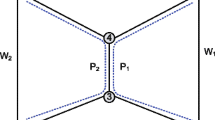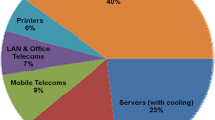Abstract
This work considers two important aspects of modern communication networks, network survivability, and energy efficiency. Survivability is a design requirement to provide failure recovery against network outages such as fiber cuts. To ensure survivability, traditionally, spare network (i.e., backup) resources are reserved in case of failures of primary (i.e., working) network resources. On the other hand, energy efficiency is required to cope with the continuous growth of the Internet traffic. Backup resources increase the energy consumption, especially if constantly powered-on. Hence, a trade-off between energy efficiency and network resiliency arises. To increase transport capacity and reduce energy consumption, wavelength division multiplexed (WDM) networks are adopted as the most practical solution for data transport in core networks, which are the focus of our work. In WDM networks, different levels of protection (i.e., dedicated, shared) can be implemented for different traffic demands, and different protection levels are characterized by different power consumptions. We consider a differentiated quality of protection (Diff-QoP) scheme where different levels of protection are provided. In this context, we investigate on two different power-reduction strategies to be used in protected WDM networks: (i) setting backup devices into low-power modes (sleep mode) and (ii) adapting the devices (i.e., transmitting/receiving equipment) usage to hourly traffic variations. We present exact modeling through Integer Linear Program (ILP) of the three scenarios and a provisioning algorithm to solve the problem of power minimized design of resilient optical core networks, under static and dynamic traffic conditions. We evaluate the performance of the proposed algorithm under static traffic conditions by comparing the obtained results with the optimal solution, in absence of traffic grooming. We show that the proposed heuristic reduces the computational time by three orders of magnitude with an optimality gap ranging from 8.88 up to 23.88%. Furthermore, we include traffic grooming and solve the problem under dynamic traffic conditions. Our findings show that enabling sleep mode (SM) for backup devices can help reduce total power consumption up to 20 and up to 38% when considering with Diff-QoP. Finally, adapting the number of transmitting/receiving devices to actual traffic needs guarantees power savings up to 80%, especially during off-peak hours.








Similar content being viewed by others
Notes
The term optical bypass indicates that connections are provisioned through a single lightpath from source to destination, with no electronic processing at intermediate nodes.
Note that multiple demands can be groomed together, at the IP layer, into one single lightpath if and only if the already established lightpath has enough channel capacity available, and the nodes where grooming is performed dispose of one free grooming-add port and one free grooming-drop per demand.
We compute the power consumption of the 40 Gbit/s transponder, in idle state, as 40% of the power consumption of the 100 Gbit/s transponder given in [22]. However, we neglect some contributions, i.e., local oscillators and digital signal processor, as they are needed only for the 100 Gbit/s coherent technology, and client-side.
Note that, in general, a different number of wavelengths can be routed over a link in the two directions. Therefore, as we assume that “bidirectional” transponders (i.e., capable of transmitting and receiving) are deployed, for each link, the number of transponders needed at its edge must be equal to the maximum of the number of wavelengths flowing in both directions, i.e., I m,n = m a x{w m,n ,w n,m }, F m,n = m a x{p m,n ,p n,m }.
As the number of wavelengths carried by a link cannot exceed its capacity (see Eq. 7), the value of M can be set as equal to W.
Note that for all traffic scenarios, the connection demands that fall into each traffic class, reported in Table 2, are selected randomly.
In Fig. 7, we use the term link to refer to bidirectional links.
References
Index Cisco Visual Networking (2016) Cisco VNI Forecast and methodology. Cisco White Paper 1:2015–2020
Zhang Y, Chowdhury P, Tornatore M, Mukherjee B (2010) Energy efficiency in telecom optical networks. IEEE Commun Surv Tutorials J 12(4):441–458
Maier G, Pattavina A, De Patre S, Martinelli M (2002) Optical network survivability: protection techniques in the WDM layer. Photon Netw Commun 4(3):251–269
Idzikowski F, Chiaraviglio L, Cianfrani A, Vizcaíno JL, Polverini M, Ye Y (2016) A survey on energy-aware design and operation of core networks. IEEE Commun Surv Tutorials 18(2):1453–1499
Srivastava S, Thirumalasetty SR, Medhi D (2005) Network traffic engineering with varied levels of protection in the next generation internet. Springer, Boston, pp 99–124. https://doi.org/10.1007/0-387-25551-6_4
Muhammad A, Monti P, Cerutti I, Wosinska L, Castoldi P, Tzanakaki A (2010) Energy-efficient WDM network planning with dedicated protection resources in sleep mode. In: IEEE global communication conference (GLOBECOM), Miami, USA, pp 1–5
Monti P, Muhammad A, Cerutti I, Cavdar C, Wosinska L, Castoldi P, Tzanakaki A (2011) Energy-efficient lightpath provisioning in a static WDM network with dedicated path protection. In: 13th international conference on transparent optical networks (ICTON), Cartagena, Spain, pp 1–5
Musumeci F, Tornatore M, López Vizcaino J, Ye Y, Pattavina A (2013) Energy-efficiency of protected IP-over-WDM networks with sleep-mode devices. Journal of High Speed Networks Journal (JHSN) 19 (1):19–32
Vizcaíno López J, Ye Y, Jiménez F, Musumeci F, Tornatore M, Pattavina A, Krummrich PM (2014) Protection in optical transport networks with fixed and flexible grid: cost and energy efficiency evaluation. Opt Switch Netw, Part A 11:55–71
Vizcaíno López J, Ye Y, Jiménez F, Duque R, Musumeci F, Tornatore M, Krummrich PM, Pattavina A (2013) Quality of protection schemes with extended flexibility for improved energy efficiency in transport networks. In: Design of reliable communication networks (DRCN), Budapest, Hungary, pp 28–35
Song L, Zhang J, Mukherjee B (2007) Dynamic provisioning with availability guarantee for differentiated services in survivable mesh networks. IEEE J Sel Areas Commun 25(3):35–43
Cavdar C, Buzluca F, Wosinska L (2010) Energy-efficient design of survivable WDM networks with shared backup. In: IEEE global telecommunications conference (GLOBECOM), pp 1–5
Jirattigalachote A, Cavdar C, Monti P, Wosinska Lena, Tzanakaki A (2011) Dynamic provisioning strategies for energy efficient WDM networks with dedicated path protection. Opt Switch Netw 8(3):201–213
Vizcaíno López J, Ye Y, Jiménez F, Duque R, Musumeci F, Tornatore M, Krummrich PM, Pattavina A (2012) Traffic and power-aware protection scheme in elastic optical networks. In: 15th international telecommunications network strategy and planning symposium (NETWORKS), pp 1–6
Coiro A, Listanti M, Valenti A, Matera F (2011) Reducing power consumption in wavelength routed networks by selective switch off of optical links. IEEE J Sel Top Quantum Electron 17(2):428–436
Vizcaíno López J, Ye Y, Jiménez F, Duque R, Musumeci F, Pattavina A, Krummrich PM (2013) Differentiated quality of protection to improve energy efficiency of survivable optical transport networks. In: Optical fiber communication conference and exposition and the national fiber optic engineers conference (OFC/NFOEC), pp 1–3
Vizcaíno López J, Soto P, Ye Y, Jiménez F, Krummrich PM (2013) Energy-efficient and low blocking probability differentiated quality of protection scheme for dynamic elastic optical networks. In: 21st international conference on software, telecommunications and computer networks - (SoftCOM 2013), pp 1–5
Vizcaíno López J, Ye Y, Jiménez F, Krummrich PM (2013) Energy and cost-efficient protection in core networks by a differentiated quality of protection scheme. In: 39th European conference and exhibition on optical communication (ECOC 2013), pp 1–3
Beletsioti GA, Papadimitriou GI, Nicopolitidis P (2016) Energy-aware algorithms for IP over WDM optical networks. J Light Technol 34(11):2856–2866
Musumeci F, Hmaity A, Tornatore M, Pattavina A (2015) Energy efficiency in reliable optical core networks. In: IEEE online conference on green communications (OnlineGreenComm) , pp 1–6
Heddeghem W, Idzikowski F, Vereecken W, Colle D, Pickavet M, Demeester P (2012) Power consumption modeling in optical multilayer networks. Photon Netw Commun 24(2):86– 102
Morea A, Spadaro S, Rival O, Perelló J, Agraz F, Verchere D (2011) Power management of optoelectronic interfaces for dynamic optical networks. In: European conference on optical communication (ECOC), Geneva, Switzerland
Ou C, Zhu K, Zang H, Sahasrabuddhe LH, Mukherjee B (2003) Traffic grooming for survivable wdm networks—shared protection. IEEE J Sel Areas Commun 21(9):1367–1383
Ahuja RK et al (1993) Network flows: theory, algorithms, and applications. Prentice Hall, Englewood Cliffs
Greentouch: Core Networks Green Meter (2015) GreenTouch Consortium white paper, available online https://s3-us-west-2.amazonaws.com/belllabs-microsite-greentouch/uploads/documents/GreenTouch-Celebration-E-Poster-Core-Network-Green-Meter.pdf
Acknowledgments
This article is based upon work from COST Action CA15127 (“Resilient communication services protecting end-user applications from disaster-based failures RECODIS”) supported by COST (European Cooperation in Science and Technology).
Author information
Authors and Affiliations
Corresponding author
Rights and permissions
About this article
Cite this article
Hmaity, A., Musumeci, F. & Tornatore, M. Power reduction strategies with differentiated quality of protection in IP-over-WDM networks. Ann. Telecommun. 73, 81–94 (2018). https://doi.org/10.1007/s12243-017-0621-4
Received:
Accepted:
Published:
Issue Date:
DOI: https://doi.org/10.1007/s12243-017-0621-4




